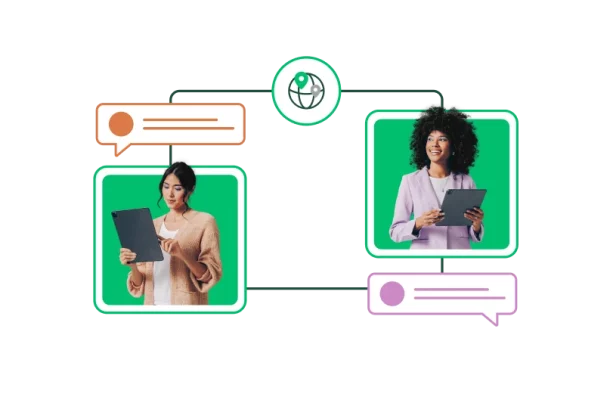What is employee experience management? Best practices and tools
A positive employee experience can give your company a boost in terms of employee engagement, satisfaction, morale and retention.

Cultivating a world-class employee experience (EX) won’t happen overnight. Your business must create employee experience management programmes and follow through on satisfaction suggestions. However, by improving the average employee experience, you’ll radically increase workplace efficiency, happiness and productivity.
What is employee experience?
The employee experience encompasses every single point of interaction that an employee has with your business. From the moment when they see your job posting to the day when they leave the company, everything feeds into their experience.
Cultural experiences, interactions with colleagues and leadership, workplace incidents and even the use of technology all go to form the employee experience. If an employee has a positive experience at work, they’re more likely to perform better. According to our research, 15% of workers aren’t satisfied with their jobs, which stems from poor experiences during the employee lifecycle.
Understanding the events and circumstances that have an impact on the employee experience is the first step towards creating a wonderful workplace for all.
What is digital employee experience?
Technology is integral to the employee experience, especially today with the prevalence of remote and hybrid work. The digital employee experience includes how employees interact with workplace technology and the support that your IT department offers them.
As technology is a huge part of the modern workplace, digital employee experiences have a significant impact.
When considering the digital employee experience, you must bear the following in mind:
- Accessibility to appropriate technology: Do your employees have access to technology that’s fast, reliable and configured in a way that enables them to work effectively?
- Mobile-friendly: Do the tools and technologies allow employees to work on mobile devices?
- Collaboration tools: Do employees have access to tools that allow collaboration with team members?
- IT response: Does your IT team provide training on new technologies? Do they respond quickly and effectively to requests for assistance?
Difference between the employee experience and the digital employee experience
The employee experience is the overall arc that your employees have when working at your company. Every single action that they take and every single minute that they spend at work influences their experience. Some aspects of those actions will inevitably be interacting with technology.
The digital employee experience has a smaller focus that only references interaction with the technologies that are required to complete work tasks. Touchpoints could include laptops, desktop computers, tablets, smartphones, headsets and the software that employees use. Any IT support that your business offers is also part of the digital experience.
Although the digital employee experience feeds into the overall experience, it’s only one piece of the puzzle.
Measure, track and improve employee engagement
Understand what motivates and engages your employees so you can improve satisfaction, performance and retention.
Importance of the employee experience
A positive employee experience influences your company’s culture and business outcomes. Happy and satisfied employees perform better, are more productive and are more likely to stay at your organisation.Here are four crucial benefits of a great employee experience:
Boost employee engagement and satisfaction
An employee who enjoys coming to work will perform more effectively. Approximately 86% of employees report that they’re satisfied with their jobs. These engaged employees typically finish tasks faster and to a much higher standard than unhappy employees. By focusing on providing a world-class employee experience, you can motivate employees and skyrocket satisfaction.
Streamline productive talent recruitment
Job seekers are looking for meaningful work and a diverse work culture. Before applying for a role, most people will read about your company on review sites and discussion boards. Prospective employees will want to know about your diversity, equity and inclusion (DE&I) initiatives, benefits, company culture, technology and other employee experience components.
If former employees leave bad reviews about your company, top talent may look elsewhere.
Increase employee retention
A positive employee experience leads directly to a high degree of employee retention. The happier your employees are, the more likely it is that they will continue to work for you. Streamlining the employee experience is a great place to begin if you want to increase retention.
Improve the customer experience
When you engage your employees, it’s more likely that they will do their best work. Happier employees will give customers a better service, thereby improving the customer experience. Whether it’s down to rapid customer support response rates or an outstanding customer advocacy team, engaged employees lead to higher customer satisfaction.
When your employees thrive, so do your customers.
What is employee experience management?
Since the employee experience includes every touchpoint that an employee has with a company, employee experience management influences each touchpoint to ensure positive experiences.
You can pinpoint weak areas by measuring the employee experience across different touchpoints. Addressing these areas first will allow you to improve the employee experience holistically. Over time, continual employee experience management can lead to a happier workplace for everyone.
To arrive at that stage, though, you must first measure your employee experience and act on the data.
How is the employee experience measured?
The employee experience comprises more than just one thing. Due to how expansive it is, you can use a blend of different tools to measure its various aspects. Bringing varying measurements and tools together will give you a more comprehensive picture of your employees’ feelings.
Several factors could affect the employee experience:
- Communication within the organisation and with external sources
- Recognition for effort and achievements
- Flexibility in terms of where and how the employee works, their working hours and the company’s dress code
- Growth in terms of employee development opportunities
- The transparency of company policies
- The clarity of company goals and employees’ roles
- The context of the employee experience within the workplace culture
- Respect from all stakeholders
Employee experience management examines the employee experience taking all of these factors into account. By making small improvements across the board, you can refine the employee experience, promote a better company culture and improve your workplace.
The five key touchpoints for monitoring and improving the employee experience are:
- Recruitment and hiring: Gain insights into the hiring process
- Onboarding: Set the stage for how an employee feels about the company
- Learning and development: Base training opportunities on employee feedback
- Retention: Stay aligned with employees’ needs and preferences
- Offboarding: Ensure that employees leave with a positive connection to your company and even continue to be advocates
Employee experience monitoring methods
You’ll need to monitor feedback throughout the employee journey to improve their experience. Here are a few practical methods you can use to monitor the employee experience.
Employee engagement surveys
It’s a good idea to conduct an employee engagement survey on an annual basis. Take note of any factors related to the employee experience and act on them to improve. You may notice that one department is less engaged than others or that certain roles feel overworked.
Employee engagement surveys are an excellent opportunity to understand how employees are feeling. If you conduct them frequently, you can take action before anything becomes more serious.
Pulse surveys

Periodic pulse surveys are short, focused surveys that you can use to assess the success of your EX efforts. These surveys allow you to tweak your EX management plan to improve effectiveness.
Use our employee satisfaction survey template as a starting point. These surveys will allow you to home in on any areas that you could improve upon.
Onboarding surveys
Onboarding is a great time to discover what new employees think about their roles, expectations and workplace resources. An onboarding survey or new hire training quiz can affect the entire employee lifecycle. If an employee’s expectations regarding their role don’t align with reality, they may feel frustrated. Understanding, from day one, what they expect will help you create the optimal experience for them.
Exit interviews and exit surveys
An exit interview should link the input from all the other surveys that an employee has taken whilst working at your organisation. Asking them about their experience will help you fill in any information that you don’t currently have. You should be able to create a picture of the entire employee experience journey with the data and find some insights into retention.
Stay interviews
Stay interviews are regular conversations between a manager and a team member. In these interviews, the manager can ask employees how they feel in their role and whether their work satisfies them. Unlike a performance review, this gives employees a platform to voice the need for more support or higher remuneration.
Taking action based on the feedback that you gain from stay interviews can show your teams that you care about their opinions. Stay interviews can help to increase employee satisfaction, motivation and other core factors influencing EX.
360-degree reviews
A 360-degree review includes input from a senior employee, a junior employee and a peer, plus a self-assessment. This review reveals more about the employee experience than traditional manager-employee reviews. You can use SurveyMonkey Custom Variables to ensure that reviewers remain anonymous. Use these surveys to investigate EX for development opportunities rather than as an overall performance review.
Improving the employee experience
A positive employee experience is vital for a productive, effective and motivated workplace. You can take several actions if you’ve measured your EX and realised that your employees aren’t happy. Here are some effective methods that you can use to improve the employee experience.
Act on employee feedback
The fastest way to make employees lose faith in your company is to never act on their feedback. Making employees fill out surveys that never result in changes will have a highly detrimental impact on morale.
Employees are more likely to share their opinions and provide useful ideas if they feel that they are being listened to. Gather your feedback and create an action plan to share with employees. Commit to listening and taking action to improve the EX.
Focus on your company culture
Your company culture encompasses the leadership style, the organisational structure, the sense of purpose and employee personalities. A great company culture is motivating, energising and empowering. Take a look at how SurveyMonkey helped Dennemeyer to build its employee-centric culture.
Improve where employees work
Provide your employees with the tools that they require to do their jobs efficiently. Ensure that tech is up to date and running smoothly.
Your physical workspace should be light and inviting. You could even include perks such as free snacks or a coffee station. Equally, you could offer the flexibility to work from home or the office.
Your company may need to adapt to hybrid work situations and consider the employee experience from that point of view. See how the State of Michigan Department of Technology in the USA engages remote workers.
Designate ownership to a leader or team
Senior HR directors are the natural choice to take ownership of your employee experience programme. They can collect data and present it alongside actionable insights.
Although your learning and development director and recruitment director may ‘own’ the programme, every leader in the organisation plays a role in creating optimal employee experiences. Encourage all leaders to send surveys, engage with data and follow through on promises.
Examine the onboarding process
As the first point of contact between an employee and a business, onboarding sets the stage for the entire employee experience. Employees learn about their work environment, culture and expectations during onboarding. If an employee loses enthusiasm during onboarding, you must examine your process and adjust it.
Show empathy
According to the CNBC|SurveyMonkey Workforce Survey May 2023, 13% of employees reported that their job roles did not satisfy them. Unsatisfied employees will leave a company if they find a new opportunity. To reduce employee churn and increase satisfaction, you should demonstrate your empathy by providing good benefits.
Look at your policies covering maternity and paternity leave, compassionate leave and leave to care for a sick dependent. Do your benefits truly show that you care? The more extensive the range of benefits you offer to your employees, the more they’ll feel cared about and valued.
Promote DE&I
DE&I efforts are important for employees. If you’re not already measuring DE&I in your workplace, it’s time to start. Ensure that you promote your DE&I efforts and keep your employees up to date with any improvements.
Software for employee experience management
Technology is a huge part of the employee experience. From the computers that employees use to get work done to the survey tools that they use to deliver feedback, everything influences their experience. Plus, organisations can use that same technology to improve the customer experience.
Here are some tools to use for digital employee experience management.
There is a range of software, tools and platforms that you can add to your employee experience tech stack:
- Open text analysis tools: Use text analysis tools to rapidly collate, process and draw sentiment insights from survey responses.
- Smart notifications: Ensure that your employees respond to surveys on time by using smart notifications that are triggered based on specific events.
- Survey tools: A comprehensive survey platform will allow you to create, customise and distribute employee experience surveys.
- AI-powered analytics: Use AI research and targeting tools to draw more meaningful insights from your surveys.
Rather than overwhelming your HR teams with various new tools and platforms all at once, consider working with SurveyMonkey. As an all-in-one platform, SurveyMonkey can streamline employee experience management and act as your base of operations for all things EX.
Start planning for better employee experience management today
Put the voice of your employees at the heart of your business. Learn how SurveyMonkey can help you attract, engage and retain top employees.
Discover more resources

Human Resources Leader
HR leaders can use this toolkit to help drive exceptional employee experiences.

Key takeaways from the British Social Attitudes Survey in 2024
Explore how to use British Social Attitudes Survey data to inform your approach to market research, customer experience, healthcare and brand voice.

What is salary sacrifice?
Salary sacrifice means exchanging employee salaries for non-cash benefits, which can reduce end-of-year tax payouts. Learn how with our guide.

See how woom enhances its employee and customer experience
Discover how woom uses SurveyMonkey to launch multilingual surveys at scale, improve the employee experience and capture customer insights.